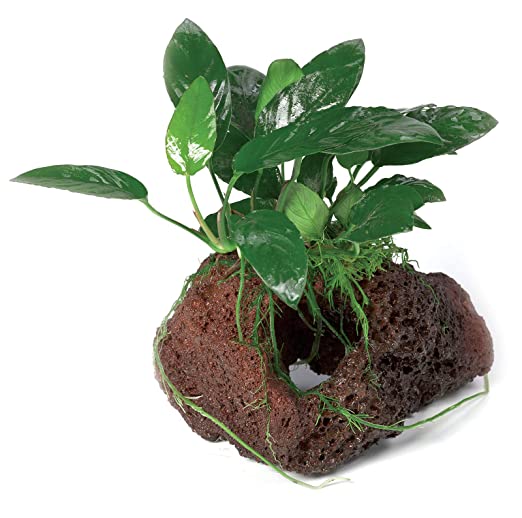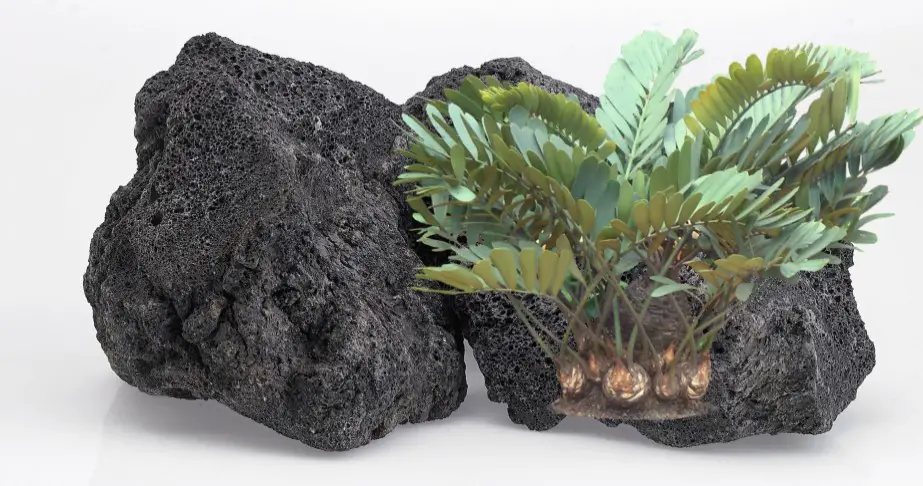Lava rocks, with their unique properties, offer a host of benefits for plant growth.
Imagine a world where your plants thrive in an environment perfectly tailored to their needs.
A world where you unlock the secrets of harnessing the power of volcanic energy to optimize their well-being.
It may sound like a scene from a science fiction movie, but with lava rocks as your secret weapon, this world can become your reality.
Whether you’re a seasoned plant enthusiast or just starting your gardening journey, incorporating lava rocks into your plant care routine can revolutionize the way your plants grow and thrive.
These unique rocks, formed through the fiery forces of volcanic eruptions, bring a plethora of benefits that can take your gardening game to the next level.
What are Lava Rocks?
Lava rocks, also known as volcanic rocks, are solidified molten lava expelled during volcanic eruptions.
They’re formed through rapid cooling and solidification, resulting in a porous and lightweight structure.
Lava rocks are primarily composed of igneous minerals such as basalt, obsidian, pumice, and scoria.
Their unique composition contributes to their beneficial properties for plant growth.
How to Use Lava Rocks for Plants (Comprehensive Guide)
Phase 1: Preparation and Selection

Preparing lava rocks for plant use
Before using lava rocks for plants, prepare them appropriately to ensure their cleanliness and suitability for your gardening needs.
- Cleaning and Sterilizing the Rocks
Begin by cleaning the rocks thoroughly to remove any dust, debris, or potential contaminants.
Rinse them under running water and consider sterilizing them using methods like boiling or soaking them in a mild bleach solution.
While lava rocks come in various sizes, it’s important to select rocks that are suitable for your specific application.
- Ensuring the Appropriate Size and Consistency
Smaller rocks are ideal for container gardening, while larger rocks may be used for landscaping projects.
- Rinsing to Remove any Remaining Debris
After cleaning and sterilizing the lava rocks, give them a final rinse to eliminate any remaining debris or cleaning agents.
Related: Best Mulch for Raised Bed Vegetable Garden
Choosing the right lava rocks
Selecting the right rocks for your plants is vital to ensure optimal growth and performance.
- Considerations for Different Plant Types and Sizes
Different plants have varying requirements.
Consider the size, root depth, and moisture preferences of your plants to determine the most appropriate lava rock size for their needs.
- Optimal Rock Size and Shape
For container gardening, choose lava rocks that are small enough to allow proper root penetration and prevent soil compaction.
Rounded or irregularly shaped rocks are preferable, as sharp edges can damage plant roots.
- Avoiding Rocks with Sharp Edges
Sharp edges can harm plant roots or cause injury during handling. Select rocks that have been naturally weathered or tumbled to avoid any sharp protrusions.
- Sourcing Lava Rocks from Reputable Suppliers
To ensure the quality and authenticity of lava rocks, purchase them from reputable suppliers who specialize in horticultural or landscaping materials.
Phase 2: Applications of Lava Rocks for Plants

Lava rocks in container gardening
Container gardening provides versatility and convenience, and lava rocks can significantly enhance the success of your potted plants.
- Using Lava Rocks as a Drainage Layer
Place a layer of lava rocks at the bottom of your plant containers to create a drainage zone, preventing water from accumulating around the roots and causing root rot.
- Mixing Lava Rocks with Potting Soil
Incorporate lava rocks into your potting mix to improve aeration, drainage, and moisture retention.
This helps to prevent soil compaction and ensures the roots receive adequate oxygen.
- Creating a Lava Rock Hydroponic System
Lava rocks can be used in hydroponic setups as a substrate for plant roots, providing stability and excellent aeration while allowing nutrient-rich water to flow freely.
Related: Best Mulches for Citrus Trees in Pots
Lava rocks in landscaping
These rocks offer exciting opportunities to enhance your landscape design and create visually stunning and low-maintenance garden spaces.
- Mulching and Ground Cover
Spread the rocks as a decorative mulch to retain soil moisture, inhibit weed growth, and provide a natural-looking ground cover that complements your garden’s aesthetics.
- Rock Gardens and Xeriscaping
Lava rocks are perfect for creating rock gardens, xeriscapes, or arid landscapes.
Their natural texture and color variations add visual interest, and their moisture retention properties help sustain drought-tolerant plants.
- Using Lava Rocks in Terrariums and Vivariums
Build captivating terrariums or vivariums by incorporating lava rocks as a base layer.
They aid in drainage and moisture control, ensuring a suitable habitat for plants and their inhabitants.
Lava rocks in aquatic plant care
Lava rocks can be beneficial in aquatic environments, enhancing water quality and providing a stable foundation for aquatic plant growth.
- Adding Lava Rocks to Aquariums
Incorporate lava rocks in aquariums as decorative elements or as a substrate for aquatic plants.
The porous structure of the rocks provides a habitat for beneficial bacteria that aid in biological filtration.
- Filtration and Water Quality Improvement
Use lava rocks in filtration systems or as a part of biological filter media to improve water quality and remove impurities, ensuring a healthier aquatic ecosystem.
- Lava Rocks in Pond Construction and Maintenance
In pond construction, lava rocks can be strategically placed to provide a natural-looking edge or as a substrate for marginal plants.
Their porous nature facilitates water circulation and biological filtration.
Related: Where to Get Wood Chips for Gardens
Phase 3: Proper Techniques and Care

Planting with lava rocks
Knowing how to plant your plants with lava rocks will maximize their growth potential and ensure long-term success.
- Layering Rocks in Pots or Containers
Start by adding a layer of the rocks at the bottom of your containers, followed by a layer of potting soil. This promotes drainage and prevents the soil from becoming waterlogged.
- Mixing Rocks with Soil for Specific Plants
For plants that prefer well-draining soil, blend lava rocks with the potting mix.
This helps improve aeration and drainage, preventing root suffocation and promoting healthier growth.
Watering and irrigation
Proper watering techniques are important when using lava rocks to maintain optimal moisture levels for your plants.
- Best Watering Practices for Plants with Lava Rocks
Water your plants thoroughly but allow excess water to drain freely through the rocks.
Avoid overwatering, as the excellent drainage properties of the rocks can lead to rapid water runoff.
- Maintaining Appropriate Moisture Levels
Monitor the moisture levels in the soil by regularly checking the moisture content using a moisture meter or manually assessing the soil’s dampness.
Adjust your watering frequency and amount accordingly.
Fertilizing and nutrient management
Understanding how lava rocks interact with nutrients is essential for proper plant nutrition.
- Understanding Nutrient Retention in Lava Rocks
Lava rocks have limited nutrient retention capacity.
They don’t provide significant nutrient content to plants. Therefore, supplement with appropriate fertilizers based on your plant’s needs.
- Supplementing with Appropriate Fertilizers
Choose fertilizers that suit your plant’s specific nutrient requirements.
Apply them according to the recommended dosage and frequency to ensure your plants receive essential nutrients for healthy growth.
- Monitoring and Adjusting Nutrient Levels
Regularly test the soil’s nutrient levels to ensure your plants are not deficient or experiencing nutrient imbalances.
Make necessary adjustments to maintain optimal growth conditions.
Cleaning and maintenance
Proper cleaning and maintenance practices will help keep your lava rocks and plants healthy and thriving.
- Removing Debris and Dead Plant Material
Periodically check your lava rocks for debris, dead leaves, or any plant material that may have accumulated.
Remove them to maintain cleanliness and prevent the growth of mold or pests.
- Replacing or Refreshing Lava Rocks Periodically
Over time, lava rocks may break down or become clogged with organic matter, affecting their drainage properties.
Consider replacing or refreshing them periodically to ensure optimum performance.
Related
- Best Mulch for Perennials
- 10 Best Mulch for Wet Areas
- Top 10 Wholesale Mulch Suppliers
- Top 7 Disadvantages of Decomposed Granite
- Grass Mulching Pros and Cons
- Gorilla Hair Mulch Pros and Cons
- Best Gravels to Walk on Bare Feet


